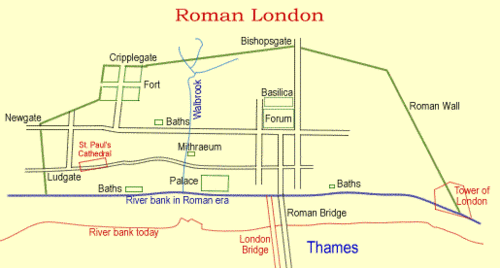
I’m just reading a few books about London in the olden days, with one particularly good read: City of London Past, by Richard Tames (1995).
For some reason, in these uncertain future times, it’s interesting to look back to the past.
Here’s a few excerpts that give you an idea as to how our modern City developed:
In Roman Times, the centre of London was at Cornhill, where the Bank of England is based, and Leadenhall market, where Lloyd’s of London is based.
At Leadenhall, the Romans built a Basilica, a combination of a town hall and law court, whilst the governor’s palace was erected at Cannon Street stations’ location.
When the walls of the City of London were built in 200 A.D., the fourth corner was near the Barbican and St Paul’s, where the Museum of London sits today (and you can find a lot more about Roman London in there), to create a 330 acre fortress.
The fort included a major amphitheatre, where today’s Guildhall Yard is found.
London’s City walls were three metres thick and six metres high, and stood for over 1,000 years, with some of the original Roman wall still to be found today.
It was the City wall from these times that gave us the term, "The Square Mile", as this defines the space of the City footprint even today.
A major temple to the Goddess Mithras existed, where Bucklersbury House is today. It was moved when the building was erected in 1954 to Queen Victoria Street, but is being moved back to its original location as a new office development for Bloomberg is being built at Walbrook Square.
Original Roman London (click for larger image)

The Roman London you can see today (click for larger image)

I’ll post more on this in the future as we move to the Vikings.
Previous entries include:
- Part One: The Romans
- Part Two: The Vikings
- Part Three: Medieval Times
- Part Four: The Tudors
- Part Five: The Stuarts
- Part Six: The Bank of England
- Part Seven: Lloyd's of London
- Part Eight: The London Stock Exchange
- Part Nine: The 1700s
- Part Ten: The Victorians
- Part Eleven: World Wars
- Part Twelve: After World War II
- Part Thirteen: The Big Bang
- Part Fourteen: Crisis
Chris M Skinner
Chris Skinner is best known as an independent commentator on the financial markets through his blog, TheFinanser.com, as author of the bestselling book Digital Bank, and Chair of the European networking forum the Financial Services Club. He has been voted one of the most influential people in banking by The Financial Brand (as well as one of the best blogs), a FinTech Titan (Next Bank), one of the Fintech Leaders you need to follow (City AM, Deluxe and Jax Finance), as well as one of the Top 40 most influential people in financial technology by the Wall Street Journal's Financial News. To learn more click here...

